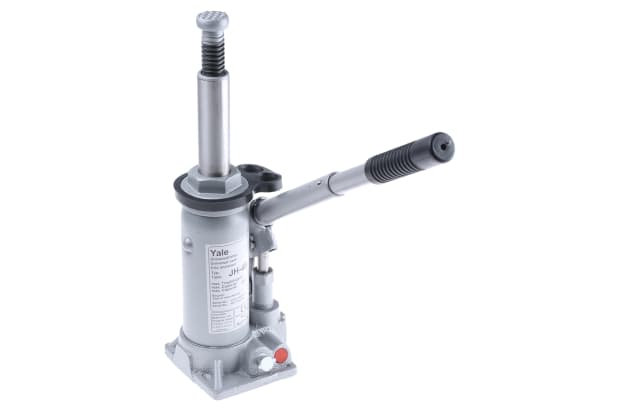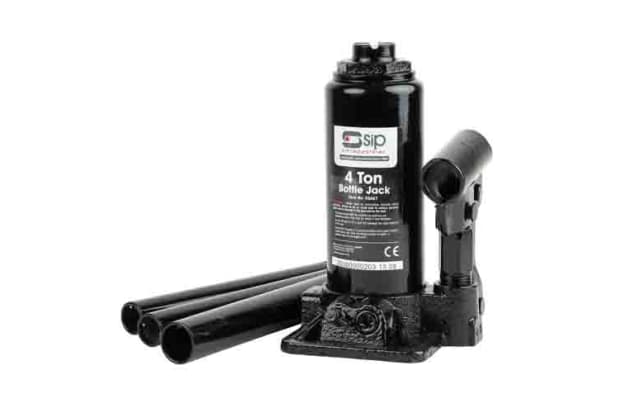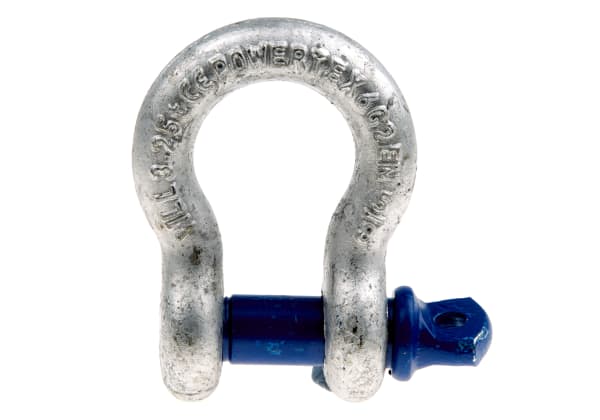- Published 24 Jan 2023
- Last Modified 29 Aug 2023
- 8 min
A Complete Guide to Axle Stands
An expert guide on axle stands, explaining what they are, how to use them, and the different types available.

What are Axle Stands?
Axle stands are specialist tools used to support cars and other vehicles that have been lifted off the ground to access the underside. They are raised using hydraulic jacks - bottle jacks - to carry out maintenance or make repairs including changing the oil or fixing an exhaust pipe. They are primarily used by professional mechanics in garages and repair shops.
These products are designed to provide firm support. Although they are designed to support vehicle axles, they can be placed under any solid part of the vehicle’s underside to provide firm support for safe working. They are positioned after the vehicle has been lifted and are safest when used on flat ground.
Axle stands are made from hardwearing, load-bearing metals like aluminium, steel or cast iron which will not slip, break or twist when exposed to the weight of a car. They are typically sold in pairs.
Axle Stands vs Jack Stands

The term jack stand is another widely used name for axle stand. They are available in tripod or tower designs and with varying weight capacities.
Jack stands are a much safer way to support a raised vehicle than simply leaving the jacks used to lift it in place. Axle stands are more robust than jacks because they do not contain hydraulic or mechanical parts which can wear out over time. They are also less prone to shifting position under stress, movement which could cause the vehicle to fall. By contrast, jack stands have a wide and stable base not prone to tilting.
Should You Use Axle Stands or Ramps?
Car ramps are angled ramps used for raising one end of a vehicle from the ground to carry out repairs.
Car ramps offer some advantages. They are easy to use - simply line a pair up with your front or rear wheels and slowly drive your car up onto them. There is no risk of not selecting the right point for jacking up the vehicle or applying an axle stand, and ramps can be used on a sloped surface.
Set against these advantages is the fact that ramps can only provide a limited amount of height at one end of the vehicle. For jobs that need free access to the underside of a car - for example, draining oil from a sump - a combination of bottle jacks and axle stands will be a better choice.
How to Use Axle Stands
Safety is always an important consideration but especially so when fatal accidents are a possibility. Here is how to use axle stands safely and correctly:
- Make sure your stands are suitable for the vehicle you will be supporting and will be able to support its full weight
- Place chocks (wheel wedges) beneath the wheels opposite the end of the car you are raising - i.e. beneath the front wheels if you are raising the back of the vehicle, and against the back wheels if you are raising the front
- Place a bottle jack under one of the two front corners and lift the vehicle to its maximum height, which will be higher than that of your stands
- Raise the stand to its full height and make sure the locking mechanism is correctly positioned
- Place the stand in an appropriate location then carefully lower the bottle jack until the vehicle is resting on the stand
- Engage the locking pins
- Repeat this process for the second front corner and then place the bottle jack under a central point and lower the rear onto stands
- Check all four stands, making sure they are steady and have no wobble, adjusting if necessary
- You can leave the jack in place for additional support if it is not causing any imbalance. Add any other suitably-shaped equipment you may have access to for further additional support, such as wheels, ramps or blocks

Where to Put Axle Stands
The positioning of your stands is key to safe use. They are primarily designed to be placed against the vehicle’s axles as these are usually strong and well-positioned. If you only require access to one end of the vehicle, you will naturally only need to deploy two stands to raise that half. However, four stands can be deployed at once to entirely lift a vehicle from the ground for more complex jobs.
They can also be positioned in other spots provided these are sturdy and will withstand the tug of gravity. Suitable jacking points on the underside of your car may be indicated in the owner’s manual and it is usually possible to use these as a location for your stands too. However, there may not be sufficient room if you plan to leave the jack in place (this is recommended for safety) - in which case you will need to identify other solid points.
Good candidates include suspension mounting points or rails for the chassis. The best spots will differ between car models. Do not use the sump (oil reservoir) or floor pan (central metal plate) as these will not be strong enough to support an axle stand.
Axle stands can also be deployed along the sills beneath the doors if these are solid, but it is a good idea to add some padding. Specially made rubber pads will help prevent damage to the vehicle bodywork or sills when attached to an axle stand’s contact points.
These stands are designed for use on flat surfaces and this is the safest way to deploy them. It is possible, however, to use them on sloped surfaces in some limited circumstances:
- Make sure the sloped surface is solid - you do not want your stands to sink into a soft surface and tilt
- Place something large and solid - for example, ramps, blocks or wheels if those have been removed - on either side of the area in which you will be working to provide extra support if the car does slip
- Ensure that the lift is as even as possible - if the centre of gravity is even slightly off, an accident could occur. A trolley jack (a hydraulic jack mounted on wheels with a pump handle) is a good tool for this - it can be left in place while the vehicle is suspended for additional safety
- Even on a slope, the stands must still be vertical, with the top over the base. To achieve this on a slanted slope you may need to only extend the stand partway, limiting the amount of workspace available
- Never work alone - have someone in the vicinity who can assist in the event of an accident
Vehicle Types
Axle stands can be used with a variety of vehicles, including:
- Standard cars
- Four-wheel drives
- Trucks
- Heavy goods vehicles (HGVs)
- Tractors
Axle Stand Types
Like most tools, axle stands are available in many different shapes and sizes, but most have an Eiffel Tower-like design with four legs connected by struts.
The principal axle stand types include:
Ratchet Axle Stands
Ratchet type stands feature a ratchet mechanism - a device that exerts force in one direction only. They are flexible and easy to adjust, allowing these stands to be placed under different areas of the car while remaining even and avoiding the obstruction caused by a jack.
Once the stand has reached the necessary height it will automatically lock into place.
Pin-Type Axle Stands
These have an opening in the base into which a thick tube or bar is attached. This, in turn, features a series of holes through which a strong locking pin is passed to adjust the height of the stand.
Pin type stands are very robust because the locking pin prevents the supporting bar from slipping. Consequently, pin-type stands are primarily used with heavy vehicles.
Locking pins can bend over time, making operation difficult, so they should be replaced regularly.
Heavy-Duty Axle Stands
These stands are designed for use with heavy vehicles. They normally have a rating of six tonnes and upwards and are frequently reinforced with rubber padding to protect their edges. Unsurprisingly, heavy-duty models typically cost more than lower capacity variations.
Axle Stand Heights

These stands are available in varying heights. The heavier the vehicle, the larger the stand required. For an average car, you will need a stand of around 300mm in height (one foot). That will increase to around 400mm (1.5 feet) for an SUV or similar vehicle.
Other sizes available range from small (270mm or 10.5 inches) to extra tall axle stands (1950mm or 6.4 feet).
Maximum Loads
Axle stands are safety-focused products. Their purpose is the safe support of heavy vehicles to enable work to be carried out underneath. Consequently, their maximum load ratings are of great importance.
The average modern car weighs around one and a half tonnes - multiply that by 100% or more for larger vehicles like vans and SUVs. Look for stands with a maximum load rating that exceeds the total weight of the vehicle you intend to lift; this will provide a margin of safety.
The most common maximum load ratings include:
Are Axle Stands Safe?
An axle stand failure is very unlikely if you follow basic safety procedures, including:
- Work carefully and proceed with caution. It is better to work with another person present in case any accidents occur
- Make sure you will be working on level and solid ground. Soft ground or a slope, even a slight one, can cause stands to tilt with potentially dangerous consequences
- Ensure your stands are strong enough to properly support the weight of your vehicle. For safety, the rated weight of your stands - how much they can safely support - should be more than the total weight of the vehicle and not just the heaviest axle
- The weight of your vehicle is normally quoted on the vehicle identification number (VIN) plate inside the door jamb on the driver’s side of the car. It can usually also be found quoted in the manual, alongside some additional context, such as the weight at the front and rear axles and the maximum permissible weight when the vehicle is fully laden
- Before employing your jacks and raising the vehicle, make sure your stands are resting firmly on the ground and apply chocks as an additional precaution against rolling
- Ensure your stands have been fully extended and locked into place before lowering the jack so that the vehicle rests on the stands. Leave the jack in place as an extra precaution but only if it is level with your stands and not causing the vehicle to rest at an angle
- Do not begin work under the vehicle without giving the stands a firm push. If they move, they have not been properly secured
- If your repair requires the wheels to be removed, prop these under the sill to provide additional support
Related Guides
Related links
- Bottle Jacks
- RS PRO Axle Stand 287mm - 427mm Maximum Range
- How To: Install and Connect a TV Aerial
- SAM Axle Stand 405mm - 600mm Maximum Range
- SAM Axle Stand 230mm - 390mm Maximum Range
- SAM Axle Stand 345mm - 580mm Maximum Range
- SAM Axle Stand 245mm - 390mm Maximum Range
- Facom Axle Stand 338mm - 500mm Maximum Range

